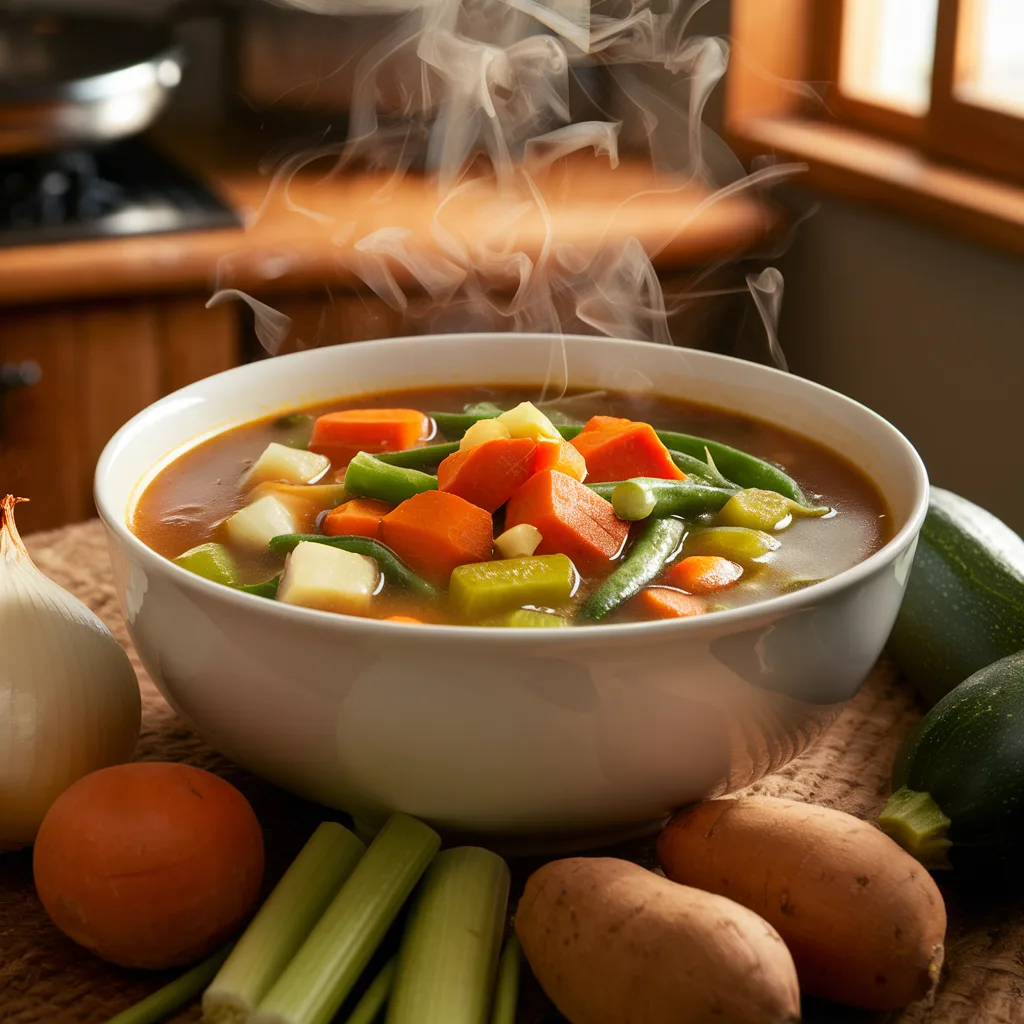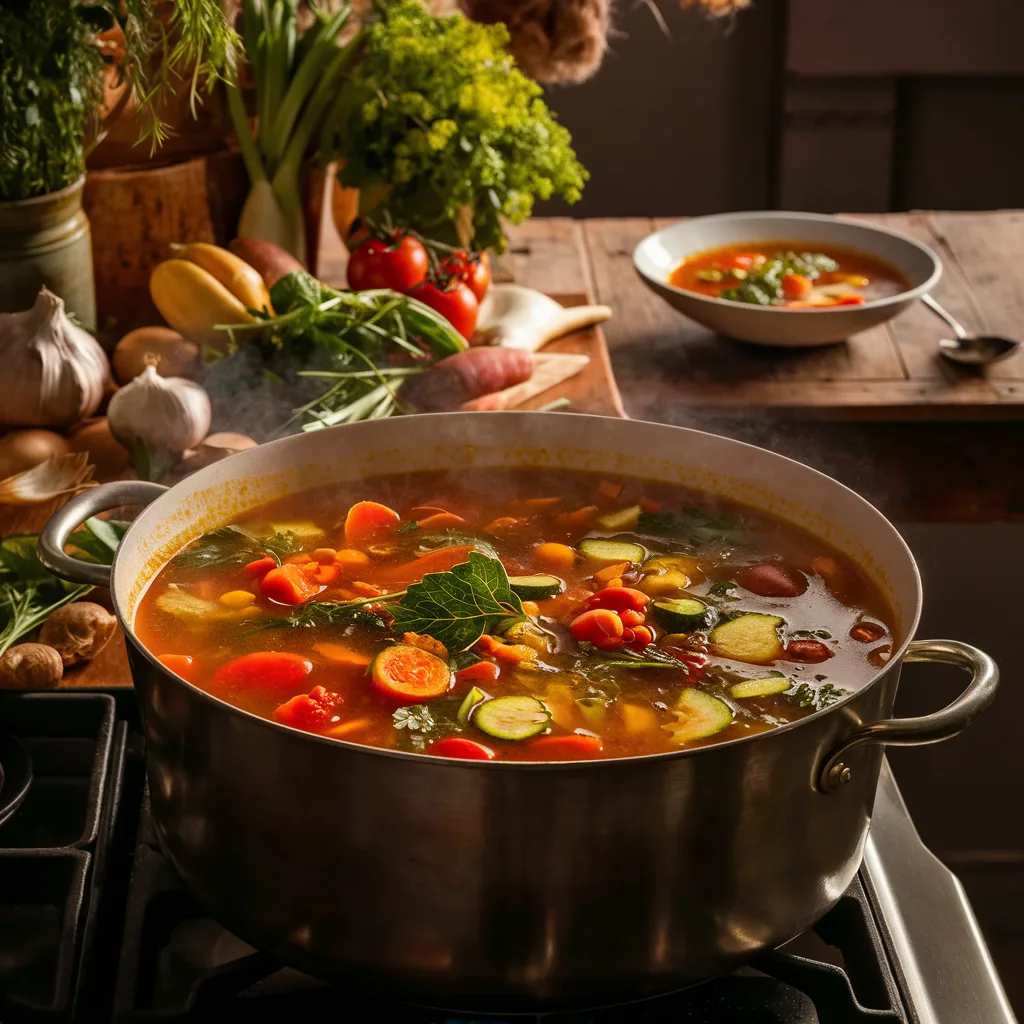When it gets colder and the days get shorter, a homemade vegetable soup is just what you need. It’s a hearty, veggie-packed dish that’s also wholesome and plant-based. This easy recipe is sure to become a favorite in your family.
This homemade 10 vegetable soup recipe is not only tasty but also very healthy soup recipe. It’s simmered to perfection, showing the power of simple, wholesome ingredients. Imagine the cozy kitchen filled with the aroma of easy vegetable soup. It’s a vegan soup recipe that will warm you up from the inside.
Key Takeaways
- Homemade vegetable soup is a versatile and nourishing dish perfect for cold nights or when craving a healthy reset.
- This easy recipe uses a variety of vegetables, herbs, and spices to create a flavorful, comforting hearty vegetable soup.
- The soup is customizable, allowing for seasonal variations and personal preferences to suit your taste.
- With a rating of 4.97 out of 5 from 258 votes, this recipe is a crowd-pleasing favorite.
- The soup can be prepared and cooked in just 40 minutes, making it a convenient and healthy meal option.
Understanding the Basics of Vegetable Soup Making
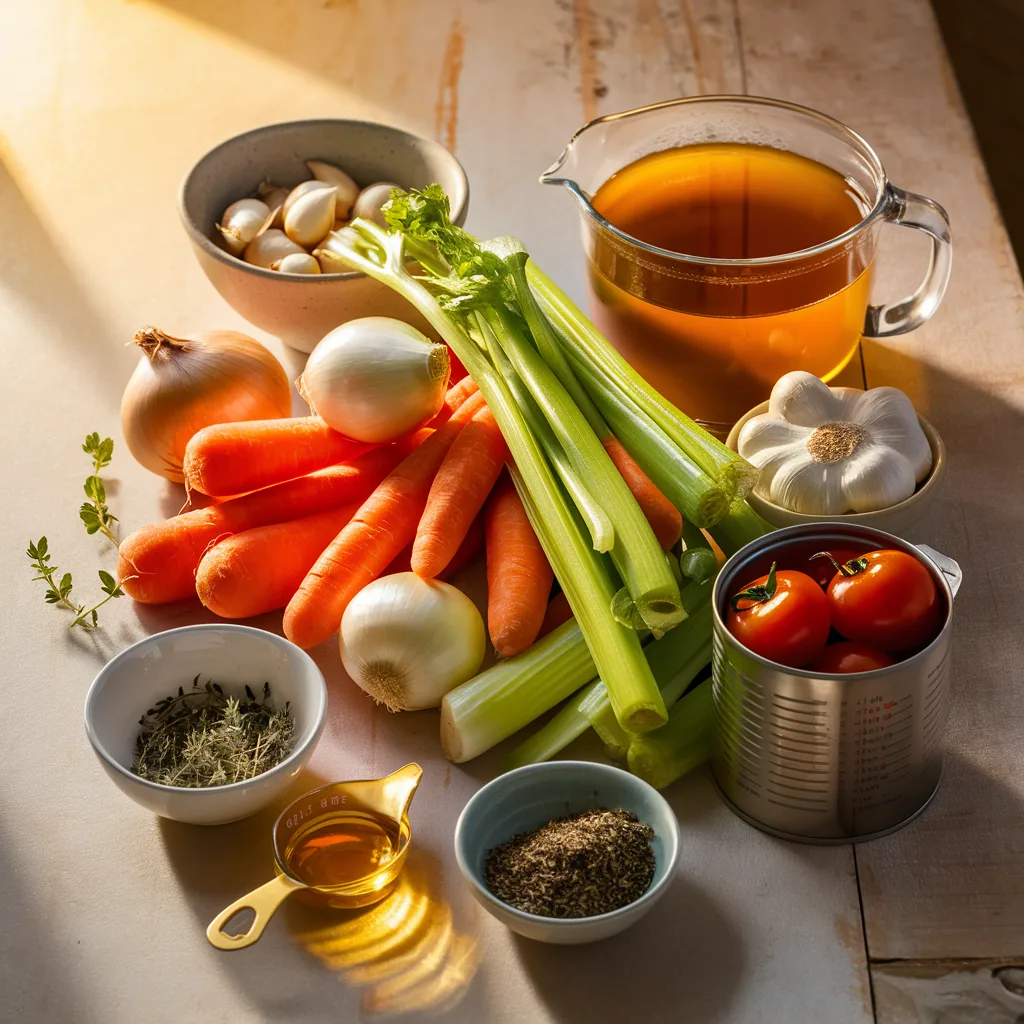
Making a tasty vegetable soup starts with knowing the basics. You need the right tools and techniques. Let’s dive into the key steps for a healthy and delicious soup.
Essential Kitchen Equipment
Good tools are the first step to a great vegetable soup. You’ll need a big pot or Dutch oven for all the veggies and broth. A sharp knife and cutting board are key for chopping onions, carrots, and celery quickly.
Base Ingredients Every Veggie Soup Needs
Some ingredients are essential for a tasty vegetable soup. You’ll need onions, carrots, celery, garlic, and a good vegetable broth. Canned diced tomatoes add depth and a bit of acidity.
Cooking Time and Temperature Guidelines
Cooking time and temperature are important for flavor and texture. Start by sautéing onions, carrots, and celery in olive oil over medium heat. Then, add broth, canned tomatoes, and seasonings. Let it simmer for 25-30 minutes to blend flavors and tenderize the veggies.
“Homemade vegetable soup is the ultimate comfort food, and with the right technique, it’s easier to make than you might think.”
Benefits of Homemade Vegetable Soup
Enjoying a warm bowl of homemade vegetable soup is great for your health. These soups are not only tasty but also packed with nutrients. They are low in calories and full of vitamins and minerals, making them perfect for a healthy diet.
One big plus of homemade vegetable soup is its low calorie count. They have fewer calories than many store-bought soups. This makes them a great choice for those watching their weight or looking for a low-calorie soup option. They are made with healthy vegetables and don’t have extra fats and sodium.
These soups are also great for boosting your immunity. They are full of fresh, seasonal vegetables and can be made to fit your dietary needs. You can add vitamins like vitamin C from bell peppers and turmeric for its anti-inflammatory benefits.
Vegetable soups are also very versatile. They are easy to make and can be customized to suit your taste. Whether you’re a vegetarian or just want to eat more veggies, these soups are a tasty and convenient option. You can try different vegetables, seasonings, and even add beans or lean proteins to make a nutritious soup that you’ll love.
In summary, adding homemade vegetable soups to your diet is a smart choice. They are low in calories and boost your immunity. These nourishing meals are a delicious way to support your health. Try making your own vegetable soups for a healthy and tasty meal.
10 Vegetable Soup Recipe: Classic Combinations
Creating delicious vegetable soups is easy with classic combinations. Onions, carrots, and celery mix for a great aroma. Sweet potatoes and zucchini add a hearty touch. These recipes are perfect for a comforting meal.
Core Vegetables and Their Preparation
The best vegetable soups start with fresh produce. Key ingredients include:
- Onions: Diced or sliced, onions add depth and sweetness to the soup.
- Carrots: Chopped or sliced, carrots provide a natural sweetness and vibrant color.
- Celery: Diced or sliced, celery contributes a savory, aromatic flavor.
- Sweet Potatoes: Peeled and cubed, sweet potatoes lend a creamy, comforting texture.
- Green Beans: Trimmed and cut into 1-inch pieces, green beans offer a delightful crunch.
- Zucchini: Diced or sliced, zucchini adds a fresh, summer-like quality to the soup.
- Leafy Greens: Chopped kale, spinach, or Swiss chard provide a nutrient-dense boost.
Seasoning and Spice Measurements
Seasoning is crucial for a balanced flavor. Common spices include:
- Garlic: 2-3 cloves, minced or crushed
- Dried Oregano: 1-2 teaspoons
- Dried Thyme: 1 teaspoon
- Bay Leaves: 1-2 leaves
- Salt and Pepper: to taste
Step-by-Step Cooking Instructions
Making a delicious vegetable soup is simple:
- Sauté the onions, carrots, and celery in a large pot with a bit of olive oil until softened.
- Add the remaining vegetables, such as sweet potatoes, green beans, and zucchini, and continue cooking for a few minutes.
- Pour in the broth (vegetable or chicken) and bring the mixture to a boil.
- Reduce the heat and let the soup simmer for 20-30 minutes, or until the vegetables are tender.
- In the last 5-10 minutes of cooking, add the leafy greens and the seasoning blend of garlic, oregano, thyme, and bay leaves.
- Adjust the seasoning with salt and pepper to taste.
These classic vegetable soup recipes are not only delicious but also a great way to incorporate a variety of fresh, seasonal produce into your meals. Experiment with different combinations and enjoy the comforting warmth and nourishment of homemade vegetable soup.
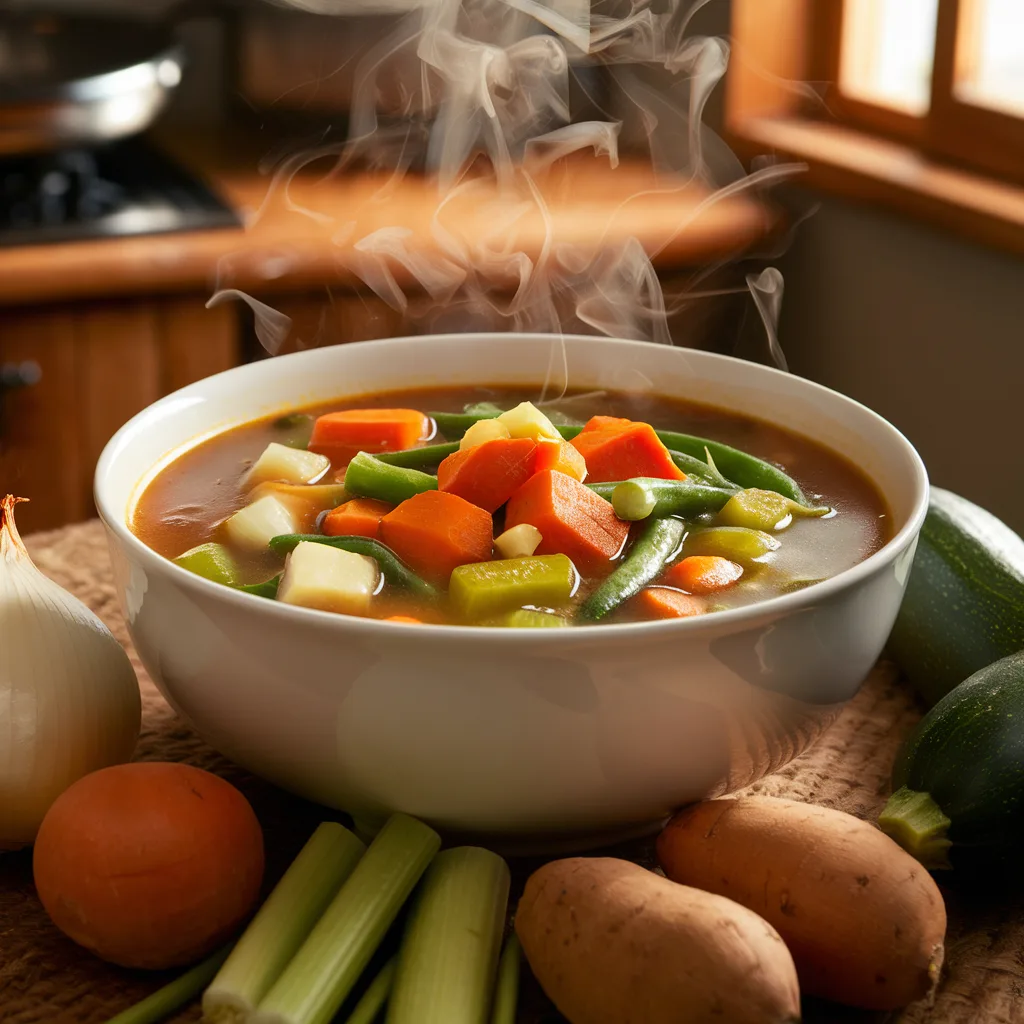
Building Flavor: Essential Herbs and Spices
Improving your spice soup or vegetable broth soup starts with herbs and spices. These ingredients can turn simple soup garnishes into a feast for the senses. Whether you’re making a hearty healthy soup recipes or trying out plant-based meals, the right mix of herbs and spices is crucial for amazing flavor.
Begin with the basics: garlic, oregano, thyme, and bay leaves. They add depth and complexity, making the soup rich and savory. For a warm touch, try curry powder or a bit of cayenne pepper. Fresh herbs like parsley or basil can also be used as soup garnishes, bringing a fresh, herbaceous flavor.
Try out different spice mixes to find flavors you love. The great thing about vegetable soup is how easy it is to change up the taste. Let your taste buds guide you as you experiment with new flavors.
| Herb/Spice | Flavor Profile | Suggested Use |
|---|---|---|
| Garlic | Pungent, savory | Sauté with vegetables or add to broth |
| Oregano | Earthy, slightly minty | Sprinkle on top or add to broth |
| Thyme | Woodsy, herbal | Add to broth or sauté with vegetables |
| Bay Leaves | Subtle, aromatic | Simmer in broth for depth of flavor |
| Curry Powder | Warm, slightly spicy | Add to broth or season the vegetables |
Mastering herbs and spices can make your vegetable soup truly special. It’s all about experimenting with flavors and enjoying the process. This way, you can create delicious soup dishes that everyone will love.
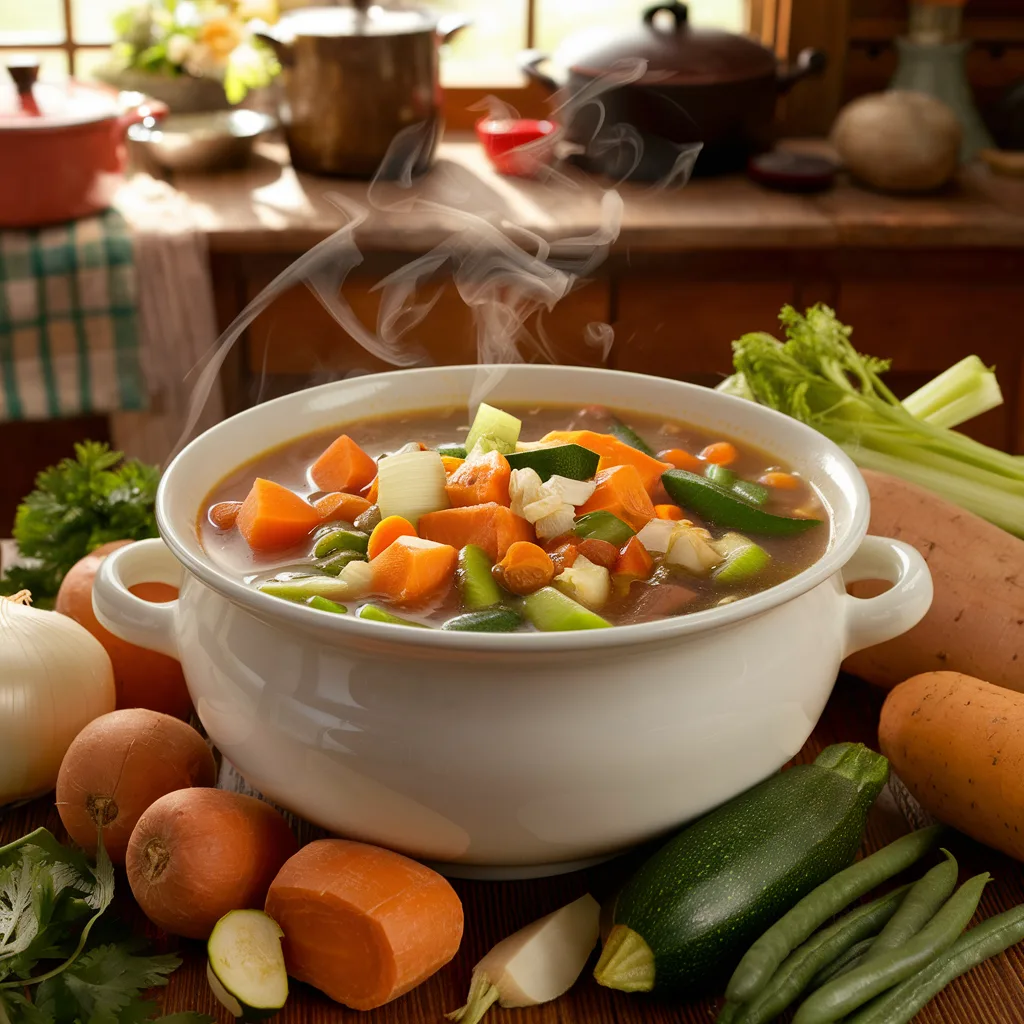
Fresh vs. Frozen Vegetables in Soup Making
Choosing between fresh and frozen vegetables can change your vegetable soup a lot. Fresh veggies give a bright taste. But, frozen veggies are handy when fresh ones are hard to find.
Best Vegetables to Use Fresh
Start your veggie soup with fresh onions, carrots, and celery. They add a strong flavor. Also, fresh seasonal vegetables like zucchini and bell peppers add color and crunch.
When to Use Frozen Alternatives
Use frozen vegetables when you’re in a hurry. Peas, corn, and green beans work well in soup. They keep their taste and texture even after freezing.
Storage Tips for Both Options
- Keep fresh vegetables in the fridge to stay fresh.
- Store frozen veggies in the freezer for months.
- Good storage keeps both fresh and frozen vegetables nutritious.
Knowing the benefits of both fresh and frozen vegetables helps make a great veggie soup. It looks good and tastes great. Try different mixes to find what you like best.
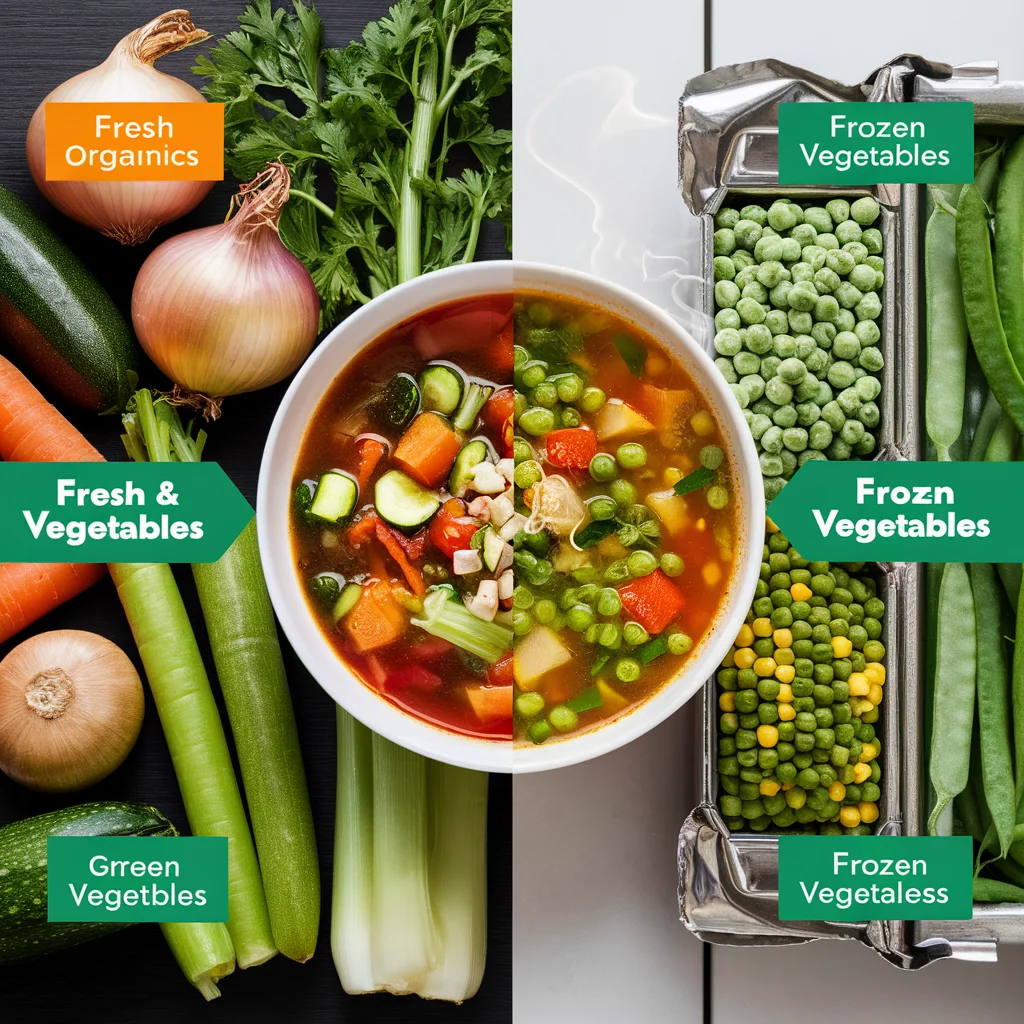
Customizing Your Soup with Seasonal Vegetables
Boost your veggie soup with seasonal produce. Enjoy a autumn vegetable soup or a summer vegetable soup. Nature’s harvest makes your soup a true delight.
Fall brings out root vegetables and winter squash. They add heartiness and rich flavors to your seasonal vegetable soup. Roasted sweet potatoes, butternut squash, and carrots add sweetness and color.
Summer brings lighter garden vegetable soup options. Zucchini, juicy tomatoes, and crisp bell peppers add freshness. They make your vegetable medley soup taste amazing and nutritious.
Choosing seasonal vegetables means better quality and flavor. It’s also more budget-friendly. Let the seasons guide your soup choices for a delicious and healthy meal.
| Seasonal Vegetable Soup Ingredients | Fall/Winter | Spring/Summer |
|---|---|---|
| Root Vegetables | Carrots, Parsnips, Potatoes, Beets | New Potatoes, Radishes |
| Winter Squash | Butternut, Acorn, Kabocha | N/A |
| Leafy Greens | Kale, Collards, Spinach | Spinach, Arugula, Swiss Chard |
| Other Vegetables | Onions, Celery, Garlic | Zucchini, Tomatoes, Bell Peppers |
“Eating seasonally is not only better for the environment, but it also ensures you’re getting the freshest, most flavorful produce in your vegetable soup.”
Broth Options and Their Impact on Flavor
Choosing the right broth is key to a tasty vegetable soup. Homemade vegetable broth gives the best taste, but store-bought options are convenient. Knowing the differences between these can make your soup delicious.
Homemade vs. Store-Bought Broth
Homemade veggie broth is the top choice for soup lovers. It’s made by simmering veggies, herbs, and spices. This makes a broth that adds amazing flavor to your soup. But, making it takes time, so store-bought low sodium vegetable soup is a quick fix for busy cooks.
Store-bought broths are easy but might have extra sodium or preservatives. To improve them, add more veggies, herbs, or a bit of white wine.
Vegetable Broth Enhancement Techniques
- Sauté onions, garlic, and celery in olive oil to add depth of flavor.
- Add fresh or dried herbs like thyme, rosemary, or bay leaves for aromatic notes.
- For a bit of acidity, add a tablespoon of lemon juice or apple cider vinegar.
- Simmer the broth with vegetable stock recipes that include mushrooms or miso paste for more umami.
Choosing the right broth is crucial for your vegetable soup’s flavor. With some trial and error, you can find the perfect mix to please your taste buds.
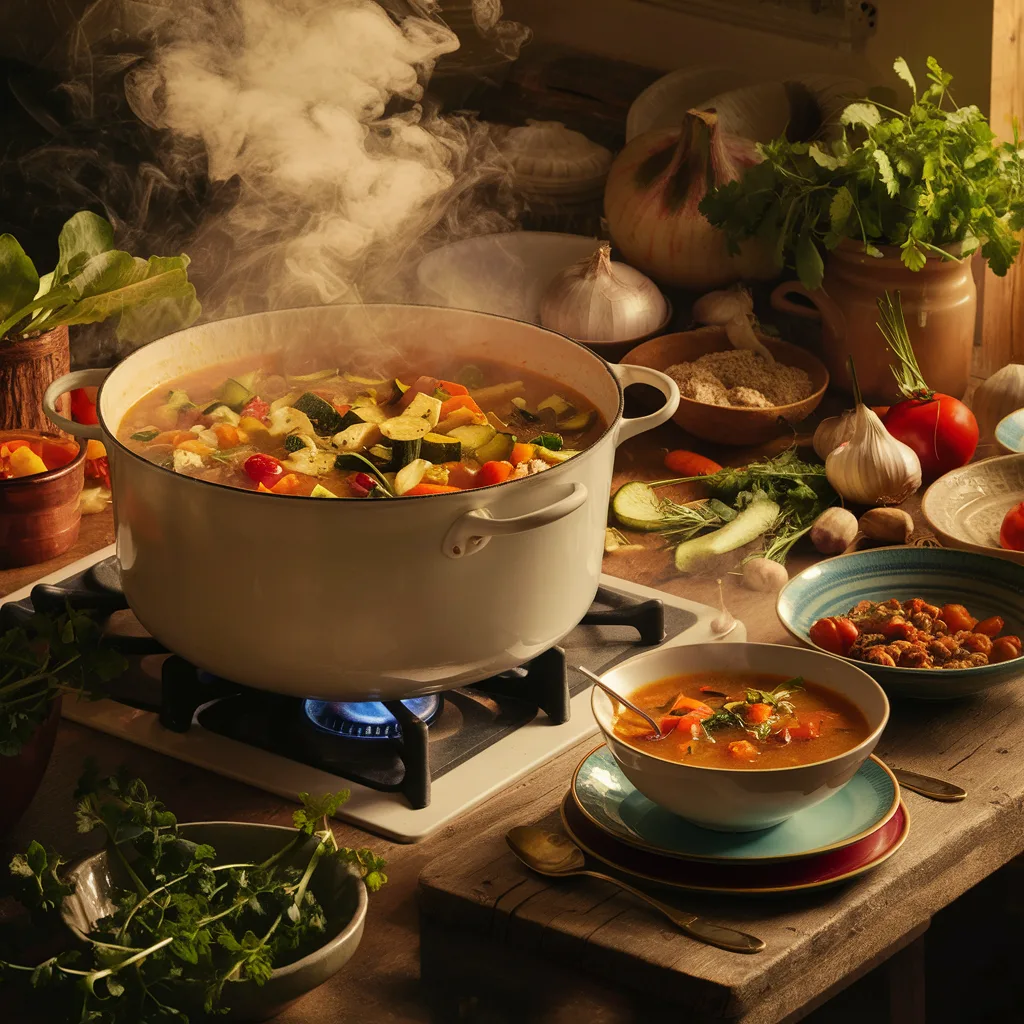
Making Your Soup Health-Conscious
To make a healthy vegetable soup, focus on using more veggies and less salt. Use herbs and spices to add flavor instead of salt. Adding beans or lentils can make your soup more filling and balanced.
If you’re gluten-free or vegan, it’s easy to make these soups work for you. Choose gluten-free broth and avoid dairy for a gluten-free vegetable soup or vegan vegetable soup. This way, you get a soup that’s good for you and supports your weight loss or plant-based diet.
| Nutrition Facts | Per Serving (1 cup) |
|---|---|
| Calories | 49 kcal |
| Fat | 0g |
| Carbohydrates | 10g |
| Fiber | 3g |
| Protein | 2g |
To make your vegetable soup even healthier, try these tips:
- Add protein with beans, lentils, quinoa, tofu, shredded chicken, or ground beef
- Use low-sodium broth to keep sodium levels down
- Thicken it with potatoes, rice, pasta, or beans for a fuller texture
- Spice it up with herbs, spices, and umami-rich ingredients for flavor
With these easy changes, you can turn your vegetable soup into a nutritious, low-calorie meal. It will support your health and wellness goals.
Storage and Reheating Guidelines
Your homemade vegetable soup is perfect for meal prep and warming up during winter. It can stay fresh in the fridge for 4-5 days. You can also freeze it for up to 3 months, keeping it ready for any time.
To reheat a single serving, microwave it for 1-2 minutes. Add a bit of water or broth if it’s too thick. For bigger amounts, heat it gently on the stovetop, stirring often. This keeps the soup’s taste and texture just right.
Storing and reheating your soup correctly is crucial. It ensures your meal prep stays tasty, whether it’s a cozy winter day or part of your meal plan. Follow these tips to enjoy your soup whenever you want.

